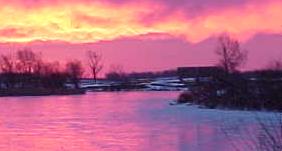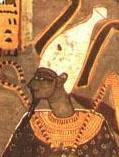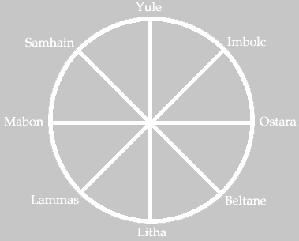![]()
![]()
![]()
![]()
![]()
![]()

Winter Solstice
![]()
![]()
![]()
![]()
![]()
![]()
|
|
|
|
|
|
|
 |
|
Winter Solstice |
||||||
|
|
|
|
|
|
|
|
| Winter Solstice What is going on during the winter solstice? The date varies slightly from year to year, and can fall anywhere between the 20th and the 23rd of December. The winter solstice in the Northern Hemisphere is the date when the sun has traveled as far south as it will ever go—the Tropic of Capricorn, one of a series of imaginary lines we draw around the circumference of the earth. This line is very near Rio De Janeiro, Brazil. So—the sun is relatively far away, It is only because the earth slants 23 degrees 27" on its axis, that we are able to have this effect. You notice—if the day is sunny—that the sun has a very low arc in the sky. You’re getting the sun from an angle. When you drive, you experience sun glare. (Conversely, at the summer solstice in the Northern Hemisphere, the sun is all the way up to the Tropic of Cancer, which is as far north as Cuba. That is when we in the Northern Hemisphere have the longest daylight.) Curiously, the sun is actually nearer the earth in January than it is in June. Not too much nearer, "only" about 3 million miles. But it is this slanting of the earth that causes the seasons, not the proximity to the sun. So much for the science! You can imagine what the effect of this diminishing sunlight must have been on the ancient peoples. These people depended on their crops for their livelihood. They had gathered in the last of their crops around October 31, what some of us call Halloween, what Pagans and Wiccans call Sanheim (SOW-en). Now the trees were bare, the ground was frozen, what if the sun didn’t come back! But it did, and various peoples around the world celebrated the return of the sun in various ways. |
 |
Ancient
Rome had a Saturnalia, some festive days of celebrating in honor of
Saturn. Ancient Egypt had the Osiris myth. Osiris He was supposedly dead and entombed on December 21 but after that night, the woman rejoiced in the return of the sun and showed an image of a newborn baby. |
|
Ancient Greece had a festival called "Festival of the Wild Women." A man representing the harvest God Dionysos was rent to pieces—later, instead of killing a man, they killed a goat, and Dionysos would be reborn as a baby. Judaism celebrates Hanukkah at around the same time, another Festival of Lights. The date varies. The first evening of Chanukah (called Erev Chanukah) starts after the sunset of the 24th day of the Hebrew month of Kislev. The Jewish use a different calendar; some years have more days than others, so Hanukkah is not always the same day, but does come close to the winter solstice. Islam- the Islam sacred time of Ramadan originated in Zoroastrianism, a religion that preceded Islam. The name also refers to the birth of the Sun. But Ramadan is part of a lunar-based calendar resulting in Ramadan starting 11 days earlier each year. So only rarely would this holiday fall at solstice. Paganism/neo-paganism: Yule was the pre-Christian Germanic Midwinter (celebration). It one of the eight solar holidays.. |
 |
In
modern neopaganism Yule is celebrated on the winter solstice, in the
Northern Hemisphere circa December 21. The word YULE means 'wheel,. Yule is at the time when the wheel of the year is at its low point. Yet as the wheel turns, it will rise again Yule celebrations at the winter solstice predate Christianity. |
| We,
all of us, are sometimes afraid of the darkness. The deepest hours of the
night are sometimes metaphorically thought of as the "dark night of
the soul," the time where struggles and worries seem magnified; the
time when people with depression are known for early (pre-dawn) awakening.
We live through our own winter solstice, times when we perhaps feel that
all the light is gone from our life, we wonder if the light will ever
return. We might seem to be struggling hopelessly with a deep, dark
problem—until the solution DAWNS on us. And
more and more light shines on our path and the actions we know that we
have to take. But even a popular song claims that the darkest part of the
night is just before dawn! |
| Winter solstice may be a time of the year when our hearts and minds are directed inward. What can this state of affairs mean for us? We might look at the concepts of darkness and light. We have experienced the darkness in our lives—yet we have the capability to emerge into the light. We speak of ignorance as being "in the dark." And only when we have been in the dark is the light the more dazzling. When we are struck by a new realization in our walk along our path, so we need the contrast of darkness to fully experience the light. |
 |
| One possibility of
this time around the winter solstice is to give ourselves a reality check.
Take the spotlight and cast it around in our own dark spaces, in our own
shadows—recognizing what is there. The shadow side we will always have,
but our moving toward the light comes with our acceptance of our shadow.
We can also take stock and see if there are any issues about which we
choose to remain in the dark, issues where we do not want to shine the
light on the facts. And in taking this stock of self and recognizing our
choosing, we have also moved out of the darkness and into the light. So, this time of the year, is a time for grounding and a time for stability. It is a time for foraging and hunting—not hunting animals, but hunting for what yours soul truly longs for. The hunting in this case is all inward. Just as plants or seeds or roots are now doing their inner work….our own inner work might be the sorting through our ideas, ideals, weighing our inner strengths-and weaknesses—and letting our true beliefs germinate—like the seeds and the roots of the plants. We want to be nourishing our roots, our sense of who we are, and what do we want to be about? What are we trying to do here? What do we want our names to stand for? What do we want to work on? What steps do we need to take to keep our roots well nourished? DB |